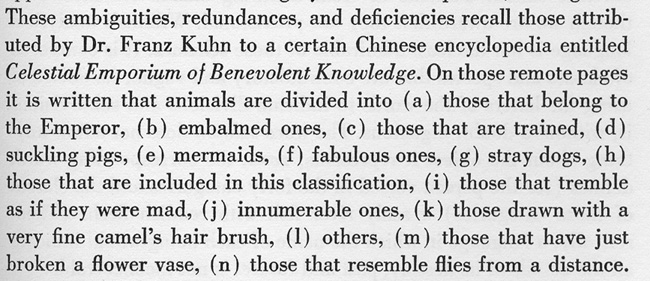Abracadabra: Language, Memory, Representation
Taxonomy in the 17th century
Today's reading: M.M. Slaughter Universal Languages Intro and Ch. 2.
A brief note on the organization of the sciences in this period. The division of the sciences we know today is foreign to this period. In the 17th century, scholars were much more likely to cross the line between science and art with impunity. Consider Bacon's classification of the sciences. It is in this period, however, that an alternat approach begins to gain support, this approach is sometimes called "Mechanistic philosophy," sometimes "Corpuscular philosophy."
Why taxonomy?
M.M. Slaughter makes the case that the 17th century was obsessed with the idea of order. From this comes the development of new taxonomies and new ways of analyzing things in the world. What kind of order though? Was there no sense of order prior to this? Compare these kinds of order:
Aristotelian Taxonomy
Aristotle's taxonomic logic governed most all learning and science up until the 17th century, and was often combined with the theological scholarship of the Church Fathers into one or more versions of the "Great Chain of Being."
Aristotles most famous taxonomic work, and most basic, is called the Categories, which is essentially a taxonomy of the things that exist (therefore it is part of the realm of ontology-- concerning what is and what is not). Existence, in this sense is not simply physical (atoms or waves or chemicals)-- indeed it could not have been based on the kinds of physical essences that we today believe to be basic.
There are 10 essences (kinds of things):
- Substances (primary) and Accidents (secondary)
- Quantity
- Quality
- Relation
- Place
- Time
- Posture
- Possession (state)
- Action
- Passion
The Great Chain of Being derives from Aristotles notion of essence (ousia) which theologians naturally interpreted as divine perfection or goodness, but which modern philosophers think of more as simply "existence" (See, e.g. Peter Suber's summary). The Chain goes from complete being (perfection) to complete non-being and includes everything in between.
Linnanean Botanical taxonomy
Linnaeus' Botanical Taxonomic work was the culmination of a century of purification, and it has become the de facto system of classifying things in our world. In the last half of the 20th century, this system of classification has also come under attack.
- Kingdom
- Phylum
- Subphylum
- Superclass
- Class
- Subclass
- Superorder
- Order
- Suborder
- Superfamily
- Family
- Subfamily
- Genus
- Subgenus
- Species
- Subspecies
Borge's "Chinese Encyclopedia"

Taxonomic principles (according to M.M. Slaughter) of the 17th century
- Decontextualization of Language from the speech situation which is made possible by the combination of literacy, printing presses and new institutions like the Royal Society.
- Objectification of words as realities in themselves, not simply as transparent labels for things.
- abstraction of words into essenses or genera
- analysis of words and things
- arrangement of words and things into hierarchies
Existing Taxonomies
An interesting question concerns how to make a taxonomy in the first place. In order to taxonomize anything one needs to make distinctions, but in order to make distinctions, one needs to have a taxonomy. The solution to this problem in practice is that each new taxonomy is based on older ones. Botanical Taxonomies, as Slaughter points out, rested on older materia medica and folk classifications.
- Theophrastus (an aristotelian classifier, based on the morphology of the plant)
- Dioscorides (a classification based on the pharmaceutical effects of plants)
- Cesalpino (another morphological portais
- Caspar Bauhin and Carl Linnaeus